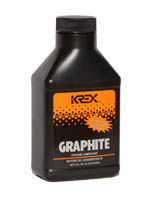In its manmade form, graphite is free from impurities, non-gritty and exists in a talcum powder like state, perfect for use in Krex Graphite Engine Lubricant®. This graphite-based product coats engine surfaces, reducing metal-on-metal wear that normally occurs at high temps. Read on to learn more about the important characteristics of the graphite in Krex Graphite Engine Lubricant®.
Graphite is a solid, not a liquid
Because graphite is a solid, it’s able to withstand much higher temperatures before boiling, almost twice the temperature at which steel boils. This translates to an engine that remains lubricated under extreme conditions, far beyond what oil can do on its own.
Color
Graphite is black, so Krex Graphite Engine Lubricant® is also black. “In our industry, black products are associated with those that are old or need changing, but that’s not the case with graphite,” says Walter Bushala, marketing manager at Krex, Inc. “It’s time to lose that stigma.” Here at Krex, Inc., we recommend changing oil or other fluids based on a time or mileage-based schedule, in lieu of appearance.
Colloidal Suspension
Similar to the DNA cells in our bodies, graphite particles remain suspended in Krex Graphite Engine Lubricant®. Our colloidal graphite suspension contains such finely divided particles that they won’t settle out, no matter how much time passes.
Graphite won’t bond to graphite
Because of the impurities introduced to all vehicles on the road, engines require a reapplication of graphite based products every 5,000 miles in order to re-coat scratched surfaces and maintain peak performance. The good news is that graphite cannot bond to itself, so graphite build-up is never a concern.
Look for an upcoming post on Krex Graphite Engine Lubricant® to learn just how it benefits the cars you service. Want to learn more now? Watch a YouTube video.
[pardot-form id=”4070″ title=”Basic_Info_Template_1″]

